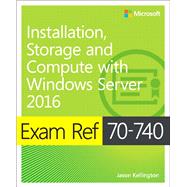Prepare for Microsoft Exam 70-740—and help demonstrate your real-world mastery of Windows Server 2016 installation, storage, and compute features and capabilities. Designed for experienced IT professionals ready to advance their status, Exam Ref focuses on the critical-thinking and decision-making acumen needed for success at the MCSA level.
Focus on the expertise measured by these objectives:
•Install Windows Servers in host and compute environments
•Implement storage solutions
•Implement Hyper-V
•Implement Windows containers
•Implement high availability
•Maintain and monitor server environments
This Microsoft Exam Ref:
•Organizes its coverage by exam objectives
•Features strategic, what-if scenarios to challenge you
•Assumes you have experience working with Windows Server in an enterprise environment; are familiar with core networking infrastructure, topologies, architectures, and protocols; and have experience with Windows clients and virtualization
About the Exam
Exam 70-740 focuses on the skills and knowledge necessary to implement and configure storage and compute features and functionality in Windows Server 2016.
About Microsoft Certification
Passing this exam earns you credit toward a Microsoft Certified Solutions Associate (MCSA) certification that demonstrates your mastery of core Windows Server 2016 skills for reducing IT costs and delivering more business value.
Exam 70-741 (Networking with Windows Server 2016) and Exam 70-742 (Identity with Windows Server 2016) are also required for MCSA: Windows Server 2016 certification.
See full details at: microsoft.com/learning








